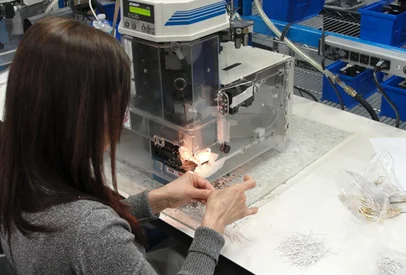Wire harnesses are wire configurations bundled in either a thermoplastic or thermoset sheathing for the purpose of managing electrical systems of devices and to protect those systems from any environmental conditions the application may be subject to. The harness itself comprises an assembly of ties, tubing, straps, lacing, sleeves, multi-pair and multi-conductor cables, coaxes, and conduits that keep the wiring system organized efficiently.
The harness specifically houses the wiring necessary to power devices and components in a multitude of applications. They are used widely in nearly every industrial sector – automotive, aerospace, industrial equipment and machinery, IT and data communications equipment, durable goods, consumer products, all electro-mechanical devices, and so on.
What is Crimping?
 The manufacture and assembly of wire harnesses is a multi-step production accomplished through manual and automated processes. One important step in assembling a wire harness is wire crimping. Crimping joins wires within the harness that connects that wire to another wiring component or to other wires. Some parts of the crimping process can be automated, such as cutting and striping, or crimping terminals on one or each side of the wires.
The manufacture and assembly of wire harnesses is a multi-step production accomplished through manual and automated processes. One important step in assembling a wire harness is wire crimping. Crimping joins wires within the harness that connects that wire to another wiring component or to other wires. Some parts of the crimping process can be automated, such as cutting and striping, or crimping terminals on one or each side of the wires.
Whether achieved through automated or manual processes, or combined, wire crimping requires the right material & tools and following step-by-step procedures. The necessary crimp tools, wire strippers, crimp terminals, heat-shrinking device, and stranded wire that meet application specs are required for wire crimping.
With materials and tools in hand, the step-by-step procedure necessary to accomplish wire crimping of your application is as follows:
1. Material: Selecting the Correct Wire for the Application
Before crimping, the correct wire gauge for the application must be selected. This entails first, knowing the device powering requirements which, secondly, will determine the necessary gauge size for the wire in order for the harness application to function as designed. There are many different gauges of wire used in the manufacturing of wire harnesses. Gauge diameters for wires are designated by the American Wire Gauge (AWG) standardized system of measurement. The design features for the device should have gauge wire diameter required to power the application.
2. Choosing a Crimp Terminal
As with wire gauges, there are many types of crimp terminals to choose from. Selection and quality of the crimp joint is determined by the application requirements of the device. There are three main factors to consider when choosing a terminal:
- Will plating be required for the terminal to ensure low contact resistance or to protect it from corrosion or both?
- Will the terminal require pre-insulation, i.e., a metal sleeve used to grip the wire?
- What is the correct turn pin for the terminal to support the creation of connectors?
3. Selecting the Crimping Tool
The right crimping tool is needed to ensure the crimp is formed to specifications. There is no universal crimping tool, they vary with crimping designs. Therefore, the tool selected for the crimp terminal must be designed for crimping that particular terminal (it must have a ratchet feature, too). The crimp terminal manufacturer should have provided the necessary crimp tooling information required for the application.
4. Making the Crimp
Once the tool, terminal, and wire gauge is determined, crimping is a multi-step process that first requires selection of the correct length of stranded wire. Next, strip the end to a length that leaves approximately one-sixteenth of an inch (1-2 mm) protruding once the wire has been inserted into the crimp. Trim the insulation from the end to expose the wire strands and insert the wire into the crimp. Make sure that every wire strand has been inserted into the crimp. Seat the crimp and wire into the crimping tool and cycle the tool until it releases the crimp. Check that it is positioned correctly and it’s secure.
5. Heat-Shrink Applications
In those applications that require heat-shrinking, a hot air gun is necessary to shrink the tubing. When heat-shrinking, be sure the sleeve is fitted correctly and positioned over the crimp and wire. It should not be covering the crimp’s terminal end.


